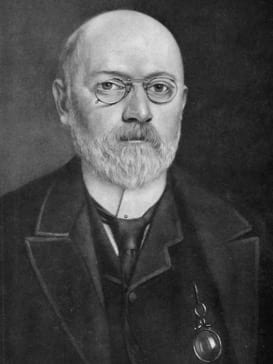Graham Steell

Graham Steell (1851-1942) was a Scottish physician and cardiologist.
Steell was the first to describe the association of oedema and peripheral neuropathy in chronic beer drinkers and in patients with beri-beri, which was later identified as a result of thiamine deficiency. Steell also observed the association between pericarditis and angina pectoris, which was documented before coronary occlusion was known
Steell is remembered for his excellence in correlating clinical signs and physiology, passionate bedside teaching, illegible notes, and brevity of speech.
He published extensive research and textbooks on fevers and cardiology. He is eponymously associated with the Graham Steell murmur (1888) of pulmonary incompetence caused by pulmonary hypertension.
Biography
- Born July 27, 1851, Edinburgh, Scotland
- Educated at the Edinburgh Academy. Originally he wanted to be a soldier, but was persuaded into medicine by his brother.
- 1872 – M.B. from Edinburgh University
- 1873 – House-physician to George William Balfour (1823–1903) at the Edinburgh Royal Infirmary, who sparked Steell’s interest in cardiology
- 1874-1877 Practiced at several fever hospitals in Edinburgh, Leeds and London
- 1877 – M.D. with gold medal for his thesis ‘On scarlatina’ from the University of Edinburgh, which described patients scarlet, enteric and typhus fevers.
- 1878 – Resident medical officer at Manchester Royal Infirmary, where he was constantly on call and lived in the hospital
- 1883 – Honorary assistant physician to the Manchester Royal Infirmary and conducted extensive research into fevers.
- 1888 – Contracted Tuberculosis, but recovered after several months leave
- 1889 – Fellowship of the Royal College of Physicians
- 1907 – Elected chair of clinical medicine, Manchester Royal Infirmary
- 1911 – Retired from the Royal Infirmary and university chair of clinical medicine
- Died January 10, 1942, Streatham Common, England. He was noted to have maintained his passion for medicine right up until his death.
Medical Eponyms
Graham Steell murmur (1888)
Soft, blowing, decrescendo early diastolic murmur of pulmonary incompetence caused by pulmonary hypertension
It leads from an accentuated second sound that mimics the murmur of aortic insufficiency and is best heard at left sternal edge, second intercostal space in full inspiration.
1888 – First described to the Manchester Medical Society in 1888. The murmur was detected with a monaural stethoscope made of box wood, with a bell-shaped earpiece. Steell attributed the murmurs origin to pulmonary regurgitation caused by high pressure in the pulmonary artery in patients with mitral stenosis, and not disease of the pulmonary valve itself
In cases of mitral obstruction there is occasionally heard over the pulmonary area (the sternal extremity of the third left costal cartilage), and below this region, for the distance of an inch or two along the left border of the sternum, and rarely over the lowest part of the bone itself, a soft blowing diastolic murmur immediately following, or, more exactly, running off from the accentuated second sound, while the usual indications of aortic regurgitation afforded by the pulse, etc., are absent. The maximum intensity of the murmur may be regarded as situated at the sternal end of the third and fourth intercostal spaces. When the second sound is reduplicated, the murmur proceeds from its latter part. That such a murmur as I have described does exist, there can, I think, be no doubt.
Graham Steel 1888
Unusually, amongst eponymous terms, this eponym stated his case for attribution on several occasions in letters to journals
I wish to plead for the admission among the recognised auscultatory signs of disease of a murmur due to pulmonary regurgitation, such regurgitation occurring independently of disease or deformity of the valves, and as the result of long-continued excess of blood pressure in the pulmonary artery
Graham Steel 1888
Notable Quotables
In regards to the emergence of many new technologies in medicine:
Clinical medicine seems to me at the present moment to be in danger of losing something of its old charm, and in the future of losing much more
Graham Steel, 1906
In relation to oedema:
Capricious distribution of dropsy is especially apt to occur in cases of the cardiac muscle-failure of beer-drinkers and of the disease known as beri-beri, of both of which diseases, it is curious to note, peripheral neuritis is a clinical feature…Curious special localizations of oedema met with, in cases of the kind, have been the scrotum, and together the upper trunk, upper extremities, and scalp and neck, so that the oedema simulates that resulting from mediastinal tumour
Graham Steel, 1906
This type of heart failure is currently understood to be due to thiamine deficiency
Major Publications
- Steell G. Physical Signs of Cardiac Disease. 1881.
- Steell G. Thesis “On Scarlatina”. 1887.
- Steell G. Murmur of high-pressure in pulmonary artery. The Medical Chronicle (Manchester). 1888; 9: 182-186 [Graham Steell murmur]
- Steell G. Mitral regurgitation. The Practitioner. 1891; 47(2).
- Steell G. Diastolic murmur in dilatation of the heart without arterial incompetence or auriculo-ventricular constriction. The Practitioner. 1895; 52(4): 254
- Steell G. The Use of the Sphygmograph in Clinical Medicine. 1889.
- Steell G. A Clinical Lecture on Pericarditis: Delivered at the Manchester Royal Infirmary. Br Med J. 1900; 27;1(2039): 181-183.
- Steell G. Text-book on diseases of the heart. 1906.
References
Biography
- Bramwell C. Graham Steell. Br Heart J. 1942; 4(3): 115–119. [Graham Steell Portrait]
- Obituary. Graham Steell (1851-1942). British Medical Journal. 1942; 1: 129-131
- Review: Graham Steell (1851-1942) JAMA. 1965; 191: 671.
- Bibliography. Steell, Graham. WorldCat Identities
Eponymous terms
- Brockbank W. The Honorary Medical Staff of the Manchester Royal Infirmary, 1830-1948. Manchester University Press, 1965
- Fraser AG, Weston CF. The Graham Steell murmur: eponymous serendipity? J R Coll Physicians Lond. 1991 Jan;25(1):66-70.
- Robbins A, Zhang G, Cadogan M. Name that murmur. LITFL 2022
- Cadogan M. Graham Steell murmur. Eponym A Day, Instagram
Eponym
the person behind the name
